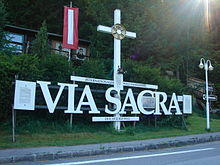
A pilgrim is a traveler who is on a journey to a holy place. Typically, this is a physical journey to some place of special significance to the adherent of a particular religious belief system. In the spiritual literature of Christianity, the concept of pilgrim and pilgrimage may refer to the experience of life in the world or to the inner path of the spiritual aspirant from a state of wretchedness to a state of beatitude.

Mount Kailash, is a mountain in the Ngari Prefecture, Tibet Autonomous Region of China. It has an altitude of 6,638 m (21,778 ft). It lies in the Kailash Range of the Transhimalaya, in the western part of the Tibetan Plateau. Mount Kailash is less than 100 km north of the western trijunction of the borders of China, India, and Nepal.
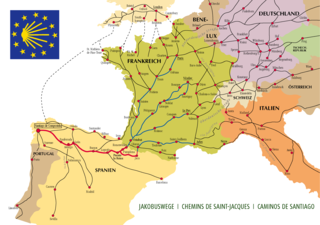
The Camino de Santiago, known in English as the Way of St James, is a network of pilgrims' ways or pilgrimages leading to the shrine of the apostle Saint James the Great in the cathedral of Santiago de Compostela in Galicia in northwestern Spain, where tradition holds that the remains of the apostle are buried.

The Via Francigena is an ancient road and pilgrimage route running from the cathedral city of Canterbury in England, through France and Switzerland, to Rome and then to Apulia, Italy, where there were ports of embarkation for the Holy Land. It was known in Italy as the "Via Francigena" or the "Via Romea Francigena". In medieval times it was an important road and pilgrimage route for those wishing to visit the Holy See and the tombs of the apostles Peter and Paul.

The Pilgrims' Way is the historical route supposedly taken by pilgrims from Winchester in Hampshire, England, to the shrine of Thomas Becket at Canterbury in Kent. This name, of comparatively recent coinage, is applied to a pre-existing ancient trackway dated by archaeological finds to 600–450 BC, but probably in existence since the Stone Age. The prehistoric route followed the "natural causeway" east to west on the southern slopes of the North Downs.

The Camino de Santiago, also known as the Way of St. James, extends from different countries of Europe, and even North Africa, on its way to Santiago de Compostela and Finisterre. The local authorities try to restore many of the ancient routes, even those used in a limited period, in the interest of tourism.
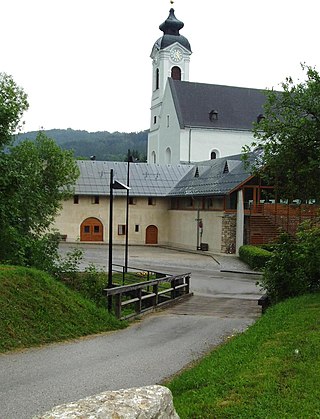
Kleinmariazell is a district of Altenmarkt an der Triesting in the Wienerwald, Lower Austria, Austria.
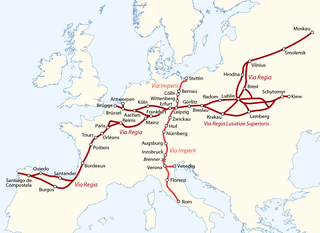
The Via Regia is a European Cultural Route following the route of the historic road of the Middle Ages. There were many such viae regiae associated with the king in the medieval Holy Roman Empire.

Schönlaterngasse is a small winding alleyway in central Vienna. In the Middle Ages it was known as Straße der Herren von Heiligenkreuz, as it passes the Heiligenkreuzer Hof. Later on, it carried several names that still referred to the Heiligenkreuzer Hof before being named after the "beautiful lantern" in 1780. The buildings along the alley date back to Baroque times.

Radke Martinez Regional Shoreline (RMRS) is a regional park on the shoreline of Carquinez Strait in Martinez, located in northern Contra Costa County, California. Formerly known as the Martinez Regional Shoreline, it was renamed on December 6, 2016, in honor of the late Ted Radke and his late wife Kathy Radke.

Heiligenkreuz is a municipality in the district of Baden, in the Austrian state of Lower Austria. It is known for the Cistercian monastery of Heiligenkreuz Abbey, the associated papal college Benedict XVI, commonly known as Hochschule Heiligenkreuz, and the Catholic Leopoldinum seminary.

The Kumano Kodō (熊野古道) is a series of ancient pilgrimage routes that crisscross the Kii Peninsula, the largest peninsula of Japan. These mountainous trails are used by pilgrims to the "Kumano Sanzan" (熊野三山) - the Three Grand Shrines of Kumano: Kumano Hongū Taisha (熊野本宮大社), Kumano Nachi Taisha (熊野那智大社) and Kumano Hayatama Taisha (熊野速玉大社). These three shrines are the holiest sites of the ancient syncretic Kumano religion.

A cavalcade is a procession or parade on horseback, or a mass trail ride by a company of riders. The focus of a cavalcade is participation rather than display. Often, the participants do not wear costumes or ride in formation. Often, a cavalcade re-enacts an important historical event and follows a long-distance trail. A cavalcade may also be a pilgrimage.
The Great German Pilgrimage of 1064–1065 was a large pilgrimage to Jerusalem which took place a generation before the First Crusade.
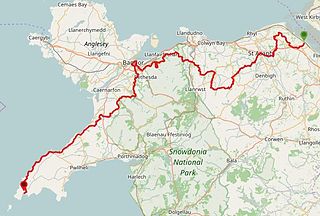
The North Wales Pilgrim's Way is a long-distance walking route in North Wales, running from near Holywell in the east to Bardsey Island in the west. The first half of the trail takes an inland route, with the second half following the north coast of the Llŷn Peninsula. It measures 133.9 miles (215 km) in length, and was officially launched at Porth y Swnt, Aberdaron on 10 July 2014.

The Templar Trail is a pilgrimage path that follows the route used in 1096 by Godfrey of Bouillon, Duke of Lower Lorraine, and his troops during the First Crusade to liberate the city of Jerusalem. It begins in Dijon, France and crosses eleven countries and two continents for 4,223 kilometres (2,624 mi). In 2006, Brandon Wilson, an American author and explorer, and Émile, a retired 68-year-old French teacher, retraced the route to create the trail. The account of their expedition with stages and distances are detailed in Wilson's 2008 book Along the Templar Trail: Seven Million Steps for Peace which won gold in the Lowell Thomas Travel Journalism Awards for best travel book in 2009.

The Austrian Pilgrim Hospice to the Holy Family is a pilgrims hostel of the Austrian Catholic Church in the Old City of Jerusalem. It is located at the corner of Via Dolorosa and el-Wad Street in the Muslim Quarter, at the third station of the Way of the Cross. Markus Stefan Bugnyar has been rector of the hospice since 2004. Founded in 1856 and opened on 19 March 1863, the hospice is the oldest national pilgrim house in the Holy Land. The Church of the Holy Family is located inside the main building.

The Our Lady of Lourdes Grotto in Heiligenkreuz is a Lourdes grotto in Heiligenkreuz, a municipality in the Vienna Woods in the district of Baden near Vienna, which was created in 2017 by the Heiligenkreuz Abbey as a religious monument in honor of the Blessed Virgin Mary. Like all similar grottoes of Our Lady of Lourdes around the world, it is reminiscent of the world-famous grotto of the apparition of the Virgin Mary in the French pilgrimage town of Lourdes.
Mount Athos has an extensive network of footpaths, many of which date back to the Byzantine period. These paths are typically trails designed for human foot traffic and mules, and are not wide enough for motor vehicles. They connect the various monasteries, sketes, cells, kathismas, and hermitages on the peninsula to each other.
